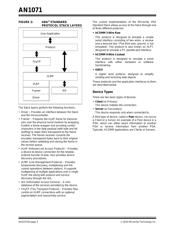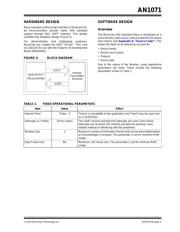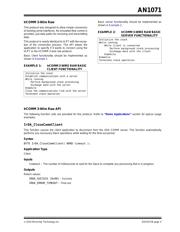下载

© 2010 Microchip Technology Inc. DS01071B-page 1
AN1071
INTRODUCTION
Infrared communication is a low-cost method of
providing wireless, point-to-point communication
between two devices. The Infrared Data Association,
often referred to as IrDA, was formed in 1994 to
develop standard methods for communicating over
short-range infrared transmissions. These standards
have continued to evolve and gain in popularity. Now, a
wide variety of devices implement the IrDA standard
specification, including computers, printers, PDAs, cell
phones, watches and other instruments.
Microchip’s 16-bit and 32-bit microcontrollers are a
perfect fit for applications wanting to support IrDA
standard communication. These low-cost
microcontrollers, with their built-in IrDA standard
support, provide an inexpensive solution with plenty of
computing power.
IrDA
®
STANDARD
Overview
The IrDA standard specification is a half-duplex
communication protocol with Serial Infrared (SIR)
transmission speeds similar to those supported by an
RS-232 port (9600 bps, 19.2 kbps, 38.4 kbps,
57.6 kbps and 115.2 kbps). Microchip currently
supports only the SIR transmission speeds.
The half-duplex nature of the communications is due to
the fact that the receiver is blinded by the light of its own
transmitter. The infrared transceiver transmits pulses in
a cone with a half-angle between 15 and 30 degrees
(Figure 1). The pulses must be visible from a distance
of one meter, but must not be so bright that the receiver
is overwhelmed at close distances. In practice, optimal
positioning for a receiver is usually a distance of 5 cm
to 60 cm from the transmitter, in the center of the
transmission cone.
Protocols
The initial specifications developed by the Infrared
Data Association provided a mechanism for converting
existing serial interfaces to infrared interfaces. These
protocols closely mimic standard serial interfaces. As
the infrared communication mechanism gained
popularity, more protocols were created to tailor the
communication format for different types of end
applications.
The infrared communication support is designed as a
Stack. Figure 2 shows the basic structure of the Stack.
FIGURE 1: OPTICAL PORT ANGLES
Author: Kim Otten
Microchip Technology Inc.
15-30 Degrees Half-Angle
≥ 15 Degrees Half-Angle
Receiver
Transmitter
IrDA
®
Standard Stack for Microchip 16-bit and
32-bit Microcontrollers








